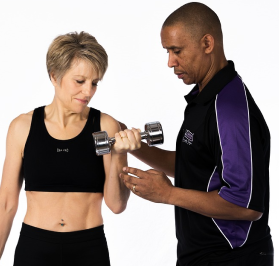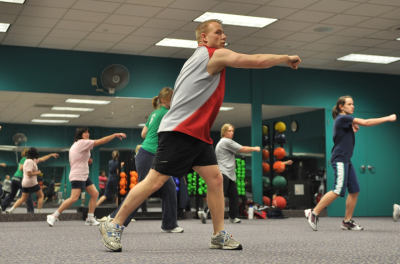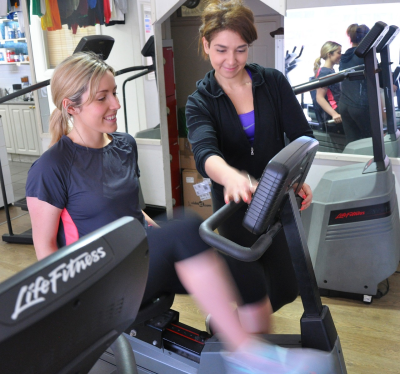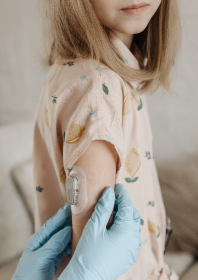This page is part of the U.S. Physical Activity IG (v1.0.0-ballot: STU 1.0 Ballot 1) based on FHIR (HL7® FHIR® Standard) R4. The current version which supersedes this version is 1.0.0. For a full list of available versions, see the Directory of published versions
Contents:
This page presents several real-world scenarios that show how the features of this implementation guide could be used to help support patients in achieving improved physical activity. These scenarios are not exhaustive. The data exchange mechanisms defined in this IG can be combined in a variety of ways and are in no way limited to the specific combinations described below. Rather, the intention is to show how the functionality enabled by this IG could be used to improve patient care.
Some of these scenarios envision insurance coverage, technical infrastructure, and applications that are not yet in existence or not yet widespread. Usage of this implementation guide is not dependent on these features, though their availability will ease the use of this guide and magnify its impact on patient care.
All scenarios in this implementation guide attempt to represent realistic patient scenarios. However, they are not based on real patients or real patient data.
Each scenario describes a series of interactions between a patient and their clinicians and/or exercise professionals. Following the 'story' of their interactions is an explanation of how the functionality described in this implementation guide supports or enables the capabilities described in the story. Each scenario also identifies places where functionality described in other implementation guides might come into play and alternate technical mechanisms that could have been used within this implementation guide to produce similar effects. The trade-offs associated with these different alternatives often have a more detailed discussion in the Design Considerations page of this implementation guide.

Mr. Khatun is a 55-year-old male weighing 190 pounds, with a height of 5' 6". This gives him a body-mass index just over 30. At his annual physical exam, his clinician Dr. Patel notes that this, combined with his high blood pressure puts him at increased risk for heart attack. He reviews the results of the electronic intake survey Mr. Khatun had completed and notes that his physical activity vital sign showed an average of only 20 minutes per week of moderate to vigorous physical activity and negligible strength-based activity and asked him more about his activity levels.
Mr. Khatun indicates that, since his children had gotten older, he has less incentive to be outside and doing things, and that his job is largely sedentary. Dr. Patel explains that Mr. Khatun's activity levels are far below the weekly target to maintain good health and that increasing his physical activity levels, plus some adjustments to his diet, could improve his weight, lower his blood pressure, as well help him to feel more energetic.
The two of them spend a few minutes discussing activities Mr. Khatun had enjoyed in the past and how he might increase his physical activity level without his children to drive that behavior. Dr. Patel captures those ideas in his notes. The two of them agree to schedule their next visit in 6 months and that by then, Mr. Khatun would aim to be doing at least 100 minutes of moderate to vigorous exercise. At the conclusion of his visit, Mr. Khatun receives a brochure with a QI-code link to an app he can use to track his physical activity. Dr. Patel also provides him a formal prescription for exercise, indicating "This prescription is as important as any medication or lab test, only this one can be free - and even fun."
At home, Mr. Khatun downloads and installs the app and, after logging in with the email address he'd given the clinic receptionist, he sees that the plan and target exercise level, as well as a copy of his "exercise prescription" have automatically been downloaded into the app. Over the course of the next 6 months, he tracks his exercise levels which are stored in an app-specific personal health record (PHR). Heart rate and step counts are automatically propagated from his phone. Mr. Khatun opts to allow the high-level summary information to flow to Dr. Patel's electronic health record (EHR). By the time he returns to the clinic for his 6-month touchpoint, the doctor can see in his EHR that Mr. Khatun has not only met, but exceeded his goal. The doctor congratulates him on his progress, the fact he's lost 10 pounds, and that his blood pressure is starting to come down. They set to work adjusting his plan and set a new target, this time for Mr. Khatun to reach the guideline target of 150 minutes/week.
Mr. Khatun's app performed a search operation on the EHR's FHIR endpoint to retrieve CarePlan, Goal and ServiceRequest resources that complied with the exercise plan, goal, and exercise prescription profiles defined in this guide. In all three cases, the search parameters included Mr. Khatun's Patient.id as determined by the log-in process as well as a category filter retrieving only those plans, goals and orders related to "physical activity".
The exercise levels and supporting information captured by Mr. Khatun's app were propagated to the app's PHR storage system using the create operation with the Days-per-week, Minutes-per-day, Minutes-per-week, and Strength Days-per-week profiles, as well as with the Time-based observation profile and the constraints established for heart rate and step count measures in the Time-based measures section of this implementation guide.
While the clinician opted not to receive the daily heart rate and exercise log information, his EHR did receive the base measures defined in this IG, including the physical activity vital sign. These Observations were transmitted to the EHR with a create operation using the Days-per-week, Minutes-per-day, Minutes-per-week, and Strength Days-per-week.
Mrs. Johansson is a 63-year old female who suffered a mild heart attack a little over a year ago. Her cardiologist, Dr. Lopez, asks her some questions about her levels of physical activity and records that she has been largely sedentary since completing her cardiac rehabilitation program. The clinician lets her know that exercise is an important part of maintaining her recovery and improving her heart's health. Mrs. Johansson confides that, despite the rehab process, she no longer feels confident exercising in the way she once did, and feels uncertain about the best way to get back to her previous levels of physical activity as some activities she used to enjoy now feel uncomfortable.

Dr. Lopez diagnoses Mrs. Johansson with "Lack of physical exercise" and refers her to a personal trainer to work with her to help her safely resume her previous activities or find alternatives she will enjoy that better accommodate her changed health status.
Dr. Lopez's nurse, Mr. Holland accesses a regional provider directory to retrieve a list of candidate trainers. He first sends a request to Mrs. Wang whose office is closest to Mrs. Johansson's home address. However, he shortly after receives a notification that Mrs. Wang's earliest opening was two months later than the referral window. Trying again, he sends a request to Mr. Matthews who is slightly further away, but still a workable distance. Mr. Matthews' clerk retrieves the referral and, after consulting briefly with Mr. Matthews submits a prior authorization request, leveraging Dr. Lopez's diagnosis of 'lack of physical exercise' as supporting information. After receiving confirmation of prior authorization, the clerk, returns an acceptance of the referral. Shortly thereafter, Mrs. Johansson receives a phone call from Mr. Matthews office to schedule her initial appointment.
Over the course of a few appointments, Mr. Matthews works with Mrs. Johansson and helps her to better understand which types of discomfort she should gently work through, and which types signal a need to change her approach to exercise. He also captures information about her levels of physical activity and uses that information to judge her progress. With some tips and adjustments, she's soon able to resume exercising in a manner similar to what she was previously accustomed and is slowly working her way towards the level of vigor and frequency she had enjoyed prior to her heart issues.
Mr. Matthews writes up a short report, summarizing his interactions with Mrs. Johansson, noting his recommended adjustments to her exercise routine as well as the targets the two of them had agreed to in terms of returning to an appropriate level of physical activity. He sends the report to Dr. Lopez and bills Mrs. Johansson's insurance for his services.
Dr. Lopez's documentation of Mrs. Johansson's low levels of physical activity are recorded using both the base measures defined in this IG, as well as a formal diagnosis captured using the Physical Activity Condition profile. This information is referenced by the referral as 'supporting information' and 'reason' for the referral, respectively.
The referral is exposed by Dr. Lopez's EHR as a ServiceRequest adhering to the referral profile defined in this guide. When the nurse reaches out to Mrs. Wang and Mr. Matthews, the EHR also stores a record exposed as a Task compliant with the Task for Referral Management profile. The EHR automatically notifies the trainer's practice manager by email (either due to a pre-existing subscription on the EHR or through custom configuration). The practice manager then triggers their system to search the EHR to retrieve both the Task and the referenced Service Request so that the referral can be evaluated.
In both cases, the personal trainer's systems perform an update on the EHR, changing
the Task. In Mrs. Wang's case, the Task.status is set to "refused" and a Task.statusReason.text string is provided
explaining the lack of availability. In Mr. Matthews' case, the Task.status is set to "accepted".
The exercise levels and supporting information captured about Mrs. Johansson's progress in Mr. Matthew's system would comply with the Days-per-week, Minutes-per-day, Minutes-per-week, and Strength Days-per-week profiles of this implementation guide.
Once Mr. Matthews has written the report his system performs a create of a
DiagnosticReport on
Dr. Lopez's EHR's endpoint, following the intervention report profile. It then updates
the previously retrieved Task and changes the Task.status to "completed" and adds a Task.output that points to the newly
created DiagnosticReport, closing the referral loop.
Task.status to "in-progress" when she had her first visit and/or by providing an interim
report (using the same process as the final report, but not yet updating the Task.status to "completed"). The Task could also have
included references to some of the observations Mr. Matthews gathered showing Mrs. Johansson's improvement.
Mr. Shevchenko is a 43-year-old male who has recently recovered from prostate cancer. A friend he'd met during chemo mentions that their neighborhood fitness center offers a program for cancer survivors to help them recover some of the muscle mass they've lost during treatment and get their bodies back into a healthier state. Mr. Shevchenko shows up at a class to see about registering, however the receptionist informs him that, for liability reasons, a referral is required to participate in the program.
Mr. Shevchenko uses his patient portal to send a message to his general practitioner, Dr. Blackrock. The clinician looks up the program details on the fitness center website. Based on the Mr. Shevchenko's most recent exam, Dr. Blackrock feels that the program is a good fit for his patient's current stage of recovery and happily writes up the referral and transmits a notification to the fitness center, then sends a reply to Mr. Shevchenko. He also makes a mental note of the program as something he wants to recommend to a couple of his other patients.
The following week, Mr. Shevchenko visits the fitness center again. The receptionist welcomes him and gives him some basic instructions for the class, then shares the good news that the program is covered under contract by his insurer.
Mr. Shevchenko completes the 10-week program, and while not fully back to his old self, feels like he's well on his way. He signs up for a fitness membership and makes plans to attend regularly with a few new friends he's met during his initial class.
The flow here is much the same as the first part of the previous scenario. The referral is exposed by Dr. BlackRock's EHR as a ServiceRequest adhering to the referral. The 'notification' to the fitness center is again through a Task adhering to the Task for Referral Management profile, though in this case it is transmitted directly to the fitness center's FHIR API with a create. The fitness center's system performs a read of the EHR to retrieve the referenced ServiceRequest.
Unlike Mrs. Johansson's previous scenario, the fitness center considers the 'referral' complete once Mr. Shevchenko has enrolled in the program and therefore updates the Task to reflect that new status once Mr. Shevchenko arrives for his first class. The design of the fitness center program also does not have funding to support writing up reports, so no DiagnosticReport is created. "Closing the loop" on the referral will have to wait until Mr. Shevchenko's next appointment with Dr. Blackrock when he can ask how things went.

Ms. Scarborough is a 32-year-old female in good physical health. However, she's dealing with the loss of a relative from a stroke. She's also just moved to a new city due to work. She's aware that her new living circumstances and the demands of her job are going to make maintaining her previous fitness regime difficult, but she's been recently reminded of the importance of maintaining a sufficient focus on keeping up her own health and well-being.
Her new job has a "health spending account" benefit that covers a range of healthcare-related benefits, including the services of a personal trainer. Ms. Scarborough meets with a few of them and chooses Ms. Rocha as someone whose style and approach is a good match for her own. The two of them meet and put together a plan to explore a variety of exercise programs to figure out which components will help Ms. Scarborough to meet her fitness objectives in her environment and time constraints. Ms. Rocha also helps Ms. Scarborough to set up an app that will allow Ms. Rocha to monitor how things are going.
The app displays the shared plan and goals that had been set and allows Ms. Scarborough to capture information about her exercise sessions and share that information with Ms. Rocha. Ms. Rocha is also able to send reading material and videos for Ms. Scarborough to review and short questionnaires to gather feedback about which exercises are working well for her and which aren't. Ms. Scarborough receives notifications about these "to dos" on her app and marks them as complete and/or fills out the requested surveys as she has opportunity. Both women also make adjustments to the exercise plan and goals - Ms. Scarborough to update the status, Ms. Rocha to set new objectives and make adjustments based on feedback and success to date. This approach of asynchronous interaction and guidance helps Ms. Scarborough to achieve her exercise objectives within her busy schedule.
Ms. Rocha uses a third-party secure FHIR server to manage information for her clients and creates updates the CarePlan and Goals, which comply with the exercise plan and goal. Ms. Scarborough's app searches and, when appropriate also updates and (for goals) possibly even creates instances.
Ms. Rocha's app also creates Task instances that comply with the SDOH Task for Patient profile to share the requests to review videos, documentation or to fill out forms. Ms. Scarborough's app then updates the Tasks to indicate when they're done (or possibly refused). If the Task was to fill out a form, the app would also render the Questionnaire and create (and sometimes update) a QuestionnaireResponse complying with the relevant SDC profiles.
Finally, Ms. Scarborough regularly tracks her fitness activities using the Time-based observation and Activity-based observation profiles and the constraints established in the Supporting Measures section of this IG. As well, using this information to support her recollection, she occasionally captures the base measures defined by this IG using the Days-per-week, Minutes-per-day, Minutes-per-week, and Strength Days-per-week profiles. Ms. Rocha can access this information by performing search operations against Ms. Scarborough's PHR.

Rosalie is a 15-year-old female with Type 1 diabetes. Rosalie’s endocrinologist Dr. Flores has been working with Rosalie's mother, Nadia, to keep Rosalie's blood glucose levels and A1c levels stable. Rosalie currently uses an insulin pump that requires her to test her blood sugar levels regularly and adjust her insulin levels based on the results. Most of the time this is manageable for the family but Rosalie has had some wider A1c fluctuations and a multiple low blood sugar events in the past year. Nadia is concerned that this will continue to get more difficult to manage over time as Rosalie gets older and expresses concern about when her daughter eventually leaves home. When discussing factors that might be impacting the accuracy of the insulin dosages, Nadia indicates that it seems to get worse during spring sports season. Last year Rosalie started working with a personal trainer as team tryouts have become more competitive. Dr. Flores asks Nadia and Rosalie to enter Rosalie's physical activity levels with the personal trainer for a few months to compare with the blood sugar readings and insulin usage.
At the end of the visit, Nadia is given instructions on how to connect to her daughter's patient portal to enter physical activity information weekly until Rosalie's next scheduled appointment. Nadia logs in to her daughter's patient record and enters the physical activity logs weekly. When Dr. Flores reviews the physical activity logs, blood sugar readings and insulin dosage she notices that overall insulin levels are lower during the spring sports season and low blood sugar were more likely to occur on heavy training weeks when Rosalie engaged in over 150 minutes of vigorous physical activity for the week. After discussing the results with Nadia and Rosalie, Dr. Flores recommends a continuous glucose monitoring insulin pump. The insulin pump's connected smartphone application allows Rosalie and Nadia to enter additional information like physical activity levels. The pump uses the combination of continuous monitoring data and the data collected through the partner application to develop a better patient profile for Rosalie that she can share with both the personal trainer and Dr. Flores. The profile allows her the trainer to better adapt the training regime to Rosalie's needs.
The physical activity levels entered by Nadia on Rosalie's behalf would include a subset of the activity-based and/or time-based measures defined in this IG. These are eventually made accessible to the trainer as FHIR Observations. The records entered by Nadia on Rosalie's behalf show her as the performer of the observation, represented using the RelatedPerson profile.